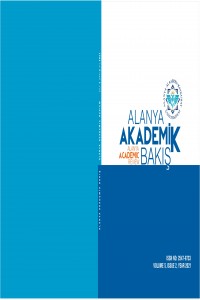Engle-Granger Cointegration Analysis Between Garch-Type Volatilities of Gold and Silver Returns
Abstract
The aim of this study is to reveal the cointegration relationship between the volatility of silver and gold returns. For this purpose, the volatility of silver and gold returns is modeled with GARCH-type models. The volatility data of the returns are obtained from 10 different GARCH-type models and using 8 different probability distributions in these models. The most adequate fit models for the volatility of silver and gold returns are found as ALLGARCH (1,1) and AVGARCH (1,1), respectively, where innovations are normal inverse Gaussian distributed. Volatility data are obtained from these models and it is determined that they are not stationary at the level. Therefore, the long-run and short-run relationships between the two volatilities are tested by the two-step Engle-Granger Cointegration method. Furthermore, the volatility spillover from silver returns to gold returns is shown by using the squared standardized residuals of the volatility model of silver returns as an exogenous variable in the nig-AVGARCH (1,1) volatility model of gold returns. It is concluded that the volatilities of silver and gold returns are cointegrated and the deviation from long-run equilibrium is rebalanced within 20 days.
References
- Bollerslev, T. P. (1986).Generalized autoregressive conditional heteroscedasticity, Journal of Econometrics, 31, pp. 307-327.
- Engle, R. F. (1982). Autoregressive Conditional Heteroskedasticity with Estimates of the Variance of United Kingdom Inflation. Econometrica, 50:4, pp. 987–1007
Engle-Granger Cointegration Analysis Between Garch-Type Volatilities of Gold and Silver Returns
Abstract
The aim of this study is to reveal the cointegration relationship between the volatility of silver and gold returns. For this purpose, the volatility of silver and gold returns is modeled with GARCH-type models. The volatility data of the returns are obtained from 10 different GARCH-type models and using 8 different probability distributions in these models. The most adequate fit models for the volatility of silver and gold returns are found as ALLGARCH (1,1) and AVGARCH (1,1), respectively, where innovations are normal inverse Gaussian distributed. Volatility data are obtained from these models and it is determined that they are not stationary at the level. Therefore, the long-run and short-run relationships between the two volatilities are tested by the two-step Engle-Granger Cointegration method. Furthermore, the volatility spillover from silver returns to gold returns is shown by using the squared standardized residuals of the volatility model of silver returns as an exogenous variable in the nig-AVGARCH (1,1) volatility model of gold returns. It is concluded that the volatilities of silver and gold returns are cointegrated and the deviation from long-run equilibrium is rebalanced within 20 days.
References
- Bollerslev, T. P. (1986).Generalized autoregressive conditional heteroscedasticity, Journal of Econometrics, 31, pp. 307-327.
- Engle, R. F. (1982). Autoregressive Conditional Heteroskedasticity with Estimates of the Variance of United Kingdom Inflation. Econometrica, 50:4, pp. 987–1007
Details
| Primary Language | English |
|---|---|
| Subjects | Economics, Finance |
| Journal Section | Makaleler |
| Authors | |
| Publication Date | May 31, 2021 |
| Acceptance Date | March 25, 2021 |
| Published in Issue | Year 2021 Volume: 5 Issue: 2 |

